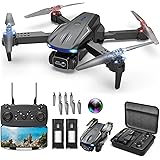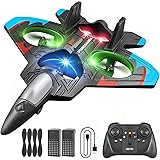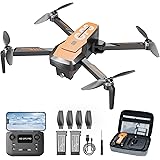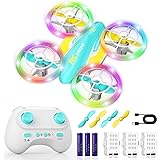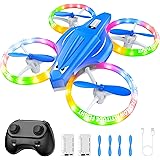Have you ever questioned the standard quadcopter design that dominates the skies? While familiar, it isn’t the only way to fly. In the video above, drone pioneers David Windestål (RC Explorer) and Le Drib from Rotor Riot explore fascinating alternatives. They dive into the world of the tricopter drone and even introduce a mind-bending bicopter drone. These designs challenge our perceptions of drone flight. They showcase how innovation continues to push boundaries in the FPV hobby. Let’s delve deeper into these unique multirotor crafts.
1. The Tricopter Comeback: A Blast From the Past
Drone technology has advanced rapidly. Modern quadcopters are incredibly smooth. They boast impressive agility and control. However, the quadcopter wasn’t always the undisputed king. There was a time when the tricopter drone reigned supreme. Early drone designs faced significant challenges. Software was slower, and ESCs (Electronic Speed Controllers) were less responsive. This made precise control difficult.
David Windestål highlights these historical limitations. Large, heavy rigs with 10-inch or even 14-inch props were common. These early quadcopters struggled with yaw authority. Yaw is the rotation around the vertical axis. It was a real problem for pilots. Imagine trying to whip a large craft around. It simply couldn’t happen with older technology. Tricopters offered a clever solution to this issue. They presented a superior flying experience for their era. This historical context is vital for understanding their resurgence.
2. How Tricopters Master Yaw Control
So, what makes a tricopter drone different? The key lies in its unique tail mechanism. Unlike quads, which rely on differential motor speed for yaw, tricopters use a tilting motor. One rear motor is mounted on a servo. This servo can tilt the motor. It moves it up to 45 degrees in either direction. This mechanical tilt provides direct and powerful yaw control. The flight controller instructs the servo. It repositions the motor as needed. This creates a highly effective yaw force.
David explains the advantage. On a quad, you must speed up two motors and slow down two others to yaw. This can affect thrust and stability. A tricopter, however, maintains constant prop speed during yaw. It simply tilts its tail motor. This allows for incredibly precise and snappy yaw maneuvers. It feels more controllable, especially in specific flight conditions. This system made tricopters incredibly stable and efficient for their time.
3. Modern Tricopter Technology: Bridging the Gap
The original tricopters were pioneers. Today’s technology brings new possibilities. Modern components significantly enhance performance. The video mentions 32-bit BL Heli ESCs. These provide much faster motor response. Gyros now update at frequencies like 8 kHz. This offers real-time feedback to the flight controller. These advancements are crucial for mini-tricopter designs.
David’s latest tricopter drone features significant innovations. He introduced a fourth servo lead for feedback. This allows the flight controller to know the servo’s exact position. This feedback loop makes corrections more efficient. The servo doesn’t need to guess its starting point. It always knows where it is. This leads to much smoother and more accurate control. This blend of classic design with modern tech creates a new flying experience.
4. The Unique Flight Experience of a Tricopter
Flying a tricopter drone is a distinct experience. It differs greatly from a quadcopter. As Le Drib discovers in the video, it has its quirks. One major difference is low-throttle behavior. Quadcopters use “air mode” for stable flight at low throttle. This allows for precise control even with minimal thrust. Tricopters need thrust to generate yaw authority. Without enough prop speed, the tilting servo has less effect. This makes low-throttle maneuvers challenging.
Pilots must be smooth with the throttle. Sudden drops can lead to instability. The craft might spin unexpectedly. This requires a different flying style. It demands more finesse and constant attention to throttle management. While challenging, this unique behavior adds to the fun. It forces pilots to adapt and master new techniques. It truly offers a different feel in the air.
5. Enter the Bicopter: Double the Fun, Double the Challenge
Beyond the tricopter, David introduces an even more exotic design: the bicopter drone. This incredible craft has only two main motors. Each motor is capable of tilting independently. It looks incredibly cool in the air. This design pushes the boundaries of conventional multirotor flight. It presents an entirely new set of control dynamics. The bicopter is specifically designed as a challenge. It’s built for those who love to experiment.
The bicopter’s flight characteristics are unique. It is flown in stabilized mode initially. Even simple maneuvers require focus. Backwards flight can be particularly challenging. It reacts unpredictably at times. The yaw authority is also quite different. David’s prototype is still in development. It showcases the vast potential for unconventional drone designs. This twin-motor setup requires different tuning. It will need specialized firmware to unlock its full capabilities.
6. Why Innovation Matters in the Drone Hobby
The exploration of tricopter drones and bicopter drones isn’t just about nostalgia. It’s about the spirit of innovation. The video’s interviewer makes a powerful point. Many people stop innovating once a “better” solution emerges. But this can stifle creativity. The mini quad era itself began with hobbyists having fun. They were not just trying to carry large cameras. They were pushing limits and experimenting. This eventually led to a whole new industry.
David Windestål’s work exemplifies this spirit. He creates these unique designs for fun and challenge. He encourages the community to get involved. By trying new things, we discover unexpected possibilities. Sharing these experiences fosters collaboration. It allows for new breakthroughs. These alternative drone designs keep the hobby fresh. They invite pilots to learn and adapt. It’s about embracing the challenge. It’s about rediscovering the joy of flight. The continuous evolution of the hobby is a testament to this collaborative spirit.
The journey with these unique multirotors is exciting. Whether it’s the classic tricopter drone or the daring bicopter drone, David’s designs reignite passion. They challenge us to fly differently. He plans to release kits for these crafts. This will allow more enthusiasts to experience them. Head to the forums to explore these designs. See if you can contribute to their ongoing development. The sky is truly the limit when it comes to drone innovation.






